August 10, 2018
Air Date: August 10, 2018
FULL SHOW
SEGMENTS
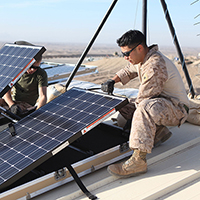
Greening the Military
View the page for this story
Deploying renewable energy helps the U.S. military function better, and saves the lives of soldiers, says Jim Goudreau, former Deputy Assistant Secretary of the Navy. He discusses with Host Steve Curwood how green technologies such as 'solar blankets' and hybrid vehicles have improved operations within the Marine Corps and the Navy. (09:35)
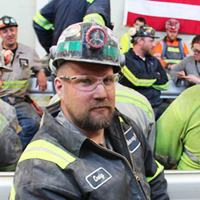
Solar Eclipsing Coal in Jobs
/ Reid FrazierView the page for this story
Coal still produces much more energy in the U.S. than solar, which powers less than one and a half percent of the grid. Yet there are now twice as many solar jobs as those in coal. As the Allegheny Front’s Reid Frazier reports, some former coal miners are becoming solar technicians, though it may involve a pay cut. (05:27)
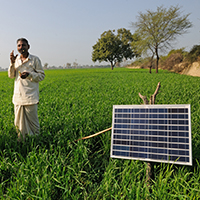
India’s Renewable Energy Revolution
View the page for this story
Prior to the signing of the Paris Climate Agreement, few nations saw India as a leader in climate policy. But in 2015, the world’s third-biggest CO2 emitter began a breathtaking transformation, embracing renewable energy and slashing growth in carbon emissions. Now, the country of 1.3 billion people is a leader of clean energy in the developing world. International environmental reporter Stephen Leahy joins host Steve Curwood to trace India’s remarkable journey to green energy. (14:21)
.jpg)
Strangers in Their Own Land: Anger and Mourning on the American Right
View the page for this story
A California sociologist ventured out of her liberal bubble to try to grasp why some conservatives reject government regulations in Louisiana, even as industry pollution persists - largely unchecked - for years. Living on Earth Host Steve Curwood interviewed Arlie Russell Hochschild, author of the book Strangers in their Own Land: Anger and Mourning on the American Right. (16:12)
Show Credits and Funders
Show Transcript
HOST: Steve Curwood
GUESTS: Jim Goudreau, Arlie Hochschild, Stephen Leahy
REPORTERS: Emmett FitzGerald, Reid Frazier
[THEME]
CURWOOD: From PRI, this is an encore edition of Living on Earth.
[THEME]
CURWOOD: I'm Steve Curwood.
In the heart of coal country, underground mining jobs are disappearing.
WILLIAMS: If you had to take another job -- in this area especially -- you’re going to take anywhere from a 50 to a 70 percent pay cut to what the next best thing is that’s out there.
CURWOOD: But some miners are finding new jobs in the solar business. Also, a social scientist looks at the cost of dirty industry in Louisiana.
HOCHSCHILD: I met people who loved the environment -- it hurt them to see a child go swimming in a lake they knew was polluted. But they felt like they had to renounce that love and in a way say look, pollution is the sacrifice we make for capitalism.
CURWOOD: We’ll have those stories and more, this week on Living on Earth, Stick Around!
[NEWSBREAK MUSIC: Boards Of Canada “Zoetrope” from “In A Beautiful Place Out In The Country” (Warp Records 2000)]
[THEME]
Greening the Military
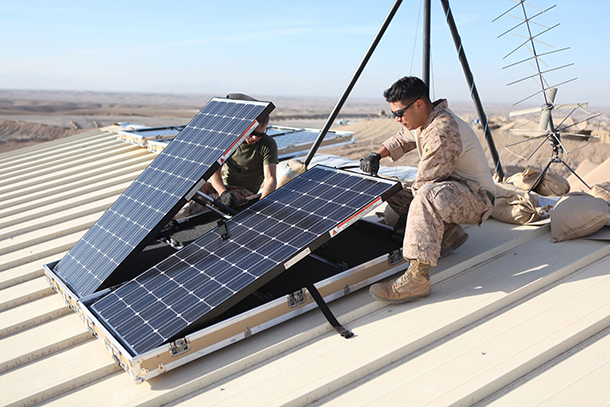
On a combat outpost in Afghanistan in November 2012, two corporals in the U.S. Marine Corps installed solar panels to provide power to radios, laptops, and computers. (Photo: Lance Cpl. Alexander Quiles / U.S. Marine Corps, CC government work)
CURWOOD: From PRI and the Jennifer and Ted Stanley Studios at the University of Massachusetts Boston, this is an encore edition of Living on Earth. I’m Steve Curwood.
Climate change is a huge threat multiplier for US military planners. And former Navy Captain Jim Goudreau assessed that threat as a supply corps officer and later as deputy assistant secretary of the Navy. He now heads the Climate group at Novartis.
Jim, welcome to Living on Earth!
GOUDREAU: Thank you very much, Steve. Pleasure to be here.
CURWOOD: So, first, brief us on why climate change has such an impact on national security.
GOUDREAU: Climate change itself may not create conflict. It may not create wars, but it's a threat multiplier that changes conditions that will lead to greater chances of physical conflict and certainly will lead to tension over resource scarcity.
CURWOOD: One need only think of Syria, I guess.
GOUDREAU: Absolutely. People that had been on the same land for generations weren't able to raise the crops they had been. They moved off that land into the city, an urban area which was already stressed for water, which was already incredibly dense from a population perspective and then put greater pressure into that existing ecosystem. Unfortunately, given competition for resources and if that becomes an issue for your survival, that becomes conflict, and all too frequently the US is involved in trying to help mediate that conflict or resolve that conflict, and so it changes where we operate and what conditions are.
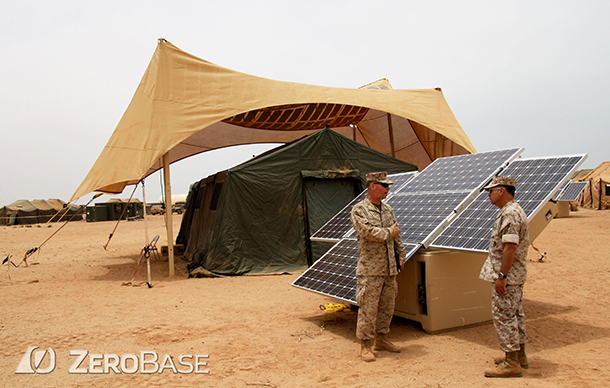
Solar panels on a U.S. Marine Corps Expeditionary Forward Operating Base (ExFOB) in Morocco. (Photo: ZeroBase Energy, Flickr CC BY-NC 2.0)
CURWOOD: Your background is in the supply corps. You’re someone who handles logistics. Tell me, what did that entail and how did that relate to energy efficiency and its relationship to climate?
GOUDREAU: At one point during my career, I handled the logistics support for all of the amphibious fleet for the US Navy in the 7th Fleet area. So, in practical terms that's from Hawaii to Pakistan and from Vladivostok down to the Antarctic. Trying to move fuel to all of those ships and all those Marines in a theater that large is incredibly complex. If everything goes perfectly well, it's a tough day to make things happen on schedule. If the slightest thing goes wrong then you miss replenishments. It impacts ship schedules, it impacts your ability to respond to natural disasters, to regional flare-ups -- and that really informed my concern on how can we perform better, how can we leverage the scarce resources in that type of environment and be better at the job that our nation charges us to do every day.
The US military burns over 1.25 billion gallons of fuel a year. The Department of Defense is the single largest consumer of fossil fuels in the US, and when you talk climate issues you can talk mitigation or adaptation. Every single gallon of fuel that we burn is carbon going into the atmosphere. That has an impact on the climate. That impact on the climate then drives operational tempo as we respond to more disasters as a result of weather events, as we respond to regional insecurity and instability which then, of course, drives greater fuel consumption, putting more carbon into the atmosphere. It just feeds into itself. And at some point, we've got to break that, and we've got to break our dependency on fossil fuels.
CURWOOD: Talk to me about the Marine Corps Experimental Forward Operating Base demonstrations where you integrated renewables for, what, there were three units -- I think -- involved in this.
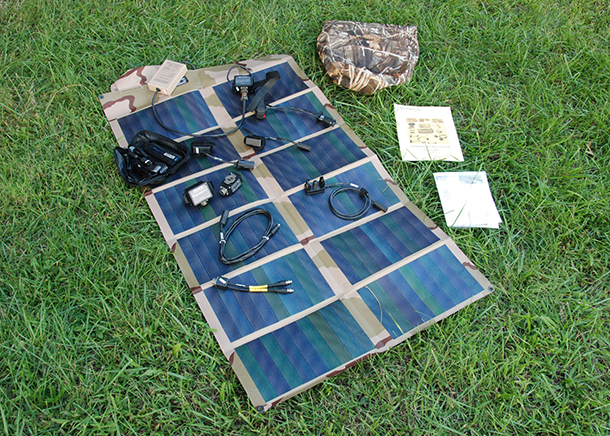
An example of a portable solar recharging system used by the U.S. military, called REPPS, or the Rucksack Enhanced Portable Power System—or simply, ‘solar blanket.’. (Photo: U.S. Army CERDEC, Flickr CC BY 2.0)
GOUDREAU: Absolutely. A couple years ago, the Marine Corps did a study, and for every 50 fuel convoys that moved in a theater, they had a casualty -- either wounded or killed. So, the Marine Corps tests gear in real circumstances with real Marines to see what can be used by them to drop their energy consumption, to reduce what has to be moved to them in the logistics convoys and to change, essentially, how they consume energy in the battle space. Those efforts led to equipment that was deployed in Afghanistan starting in 2010, and on two of their forward operating bases, the Marine Corps was able to completely reduce the need for fuel resupply. They took solar units, and they hooked up their computers, their radios, their artillery targeting software, all to solar arrays that had battery storage, and they were able to fight the fight on a daily basis without moving liquid fuel in. They also did that in another location and were able to reduce their fuel requirements by over 90 percent. In real terms, that means a young Marine didn't have to go into harm's way simply to move fuel to that forward operating base.
CURWOOD: So, what have you seen in terms of how renewables can improve operations?
GOUDREAU: Renewables themselves give, in the Marine Corps’ case, greater agility, greater speed, greater self-sufficiency. Marines don't really focus on environmental issues. They need to be lethal, and if you can tell a Marine that I'm going to give you gear that gives you a better chance of winning the battle and coming home, then they're all for it. An infantry Marine will carry about 120 pounds in their pack today when they go out on patrol. The Marine Corps in 2010 sent out flexible solar blankets, small blankets you could roll up, and rechargeable batteries for the equipment that they had in their pack and that they would use for the combat gear. And instead of putting 25 to 30 pounds of batteries into their pack, they were able use rechargeable batteries and solar blankets to execute their mission, which means as a young marine you're either lighter and faster and more agile, or you can put more ammunition into that pack and be more lethal during that mission, and give yourself a greater chance of coming home alive.
CURWOOD: And describe a solar blanket for me, would you please?
GOUDREAU: If you were to take a piece of canvas maybe two feet by two feet and put a very thin, flexible solar cell onto it, you can just roll that up and put it into your backpack. Or you can clip it onto the outside of your backpack and as you're walking along, you’re getting a charge from the sun. When you stop, you can lay that out and connect batteries and recharge those batteries.
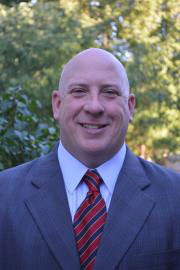
Jim Goudreau is a former Deputy Assistant Secretary of the Navy. (Photo: Jim Goudreau)
CURWOOD: Broadening that out now to the Pentagon's operations across our fighting forces -- how efficiently is our military working now, from an energy standpoint?
GOUDREAU: I think our military is more efficient now than they have been before, even though consumption has gone up. One thing to understand is that the equipment that we’re bringing to the fleet and bringing to the Marine Corps consumes more energy because we have more computers, more electronics, greater requirements from that equipment as they operate in a networked combat environment, but they’re more effective, the Navy and the Marine Corps are recognizing that the enemy knows that we need fuel and if they can interrupt that supply, then that gives them an advantage. Being able to install things like variable speed motors, pumps and drives, hybrid electric drives on board destroyers and to incentivize different behaviors on board a ship, are moving the Navy to where they can stay on station longer, and they can be more capable war fighters.
CURWOOD: Now, to what extent do you anticipate that the incoming Trump administration and the Secretary of Defense General Jim Mattis will embrace this approach?
GOUDREAU: Well, I certainly think that Secretary Mattis will do so. He, while he was in charge of theater in central command, made a very strong push with his troops to focus on operational energy -- to understand what they were consuming, what benefit they got operationally from it, and to try to reduce vulnerabilities by using less fuel. He understands the operational vulnerabilities that exist because of the fuel that we use, and I feel that he's going continue to look at developing capability that can make our Marines more agile and more lethal. He's a tremendously well-read and serious member of the profession of arms. He understands what's happened with forces in the past who have had energy challenges, and I think he'll be determined to prevent that from happening in the future.
CURWOOD: By the way, Jim, before you go, a number of government scientists feel that they are under assault by the incoming administration. How important is science to the military?
GOUDREAU: It's incredibly important. It's the foundation for our capability. It serves as a foundation for forecasting into the future. Just simply technology development. Nuclear propulsion...we wouldn't have the fleet and the capabilities that we have today if the government had not made significant investments in basic science, basic research and development, and then applied science and research and development. If we didn't invest in satellites, we wouldn't have the weather forecasting technology that we have today that's critical to safe operations at sea. We wouldn't have GPS, which is critical to operations all over the globe for the US military. So I would say that it serves as the foundation for our capability and will continue to serve as the foundation and absolute requirement for our continued operations.
CURWOOD: Jim Goudreau is a former Deputy Assistant Secretary of Navy and now Head of Climate at Novartis. Captain Goudreau, thank you so much for taking the time with us today.
GOUDREAU: Thank you so much, Steve.
Related links:
- Utility Dive: “Will Trump disrupt the US military’s clean energy mission?”
- Jim Goudreau’s “About” page on the U.S. Navy’s Green Fleet website
- About the USS Makin Island hybrid Navy amphibious assault vessel
- The Marine Corps Expeditionary Energy Office (formerly ExFOB)
[MUSIC: Khaled, “Melha” on Kenza, arr. Ahmed Hamadi/Khaled, Ark21 Records]
CURWOOD: Coming up – A power shift in India. How solar and a coal moratorium are charting the path forward. That’s just ahead here on Living on Earth -- stay tuned.
ANNOUNCER: Support for Living on Earth comes from the Gordon and Betty Moore Foundation and from a friend of Sailors for the Sea, working with boaters to restore ocean health.
[MUSIC: Ry Cooder, Manuel Galban, “Drum Negrita” on Mambo Sinuendo, Nonesuch Records]
Solar Eclipsing Coal in Jobs
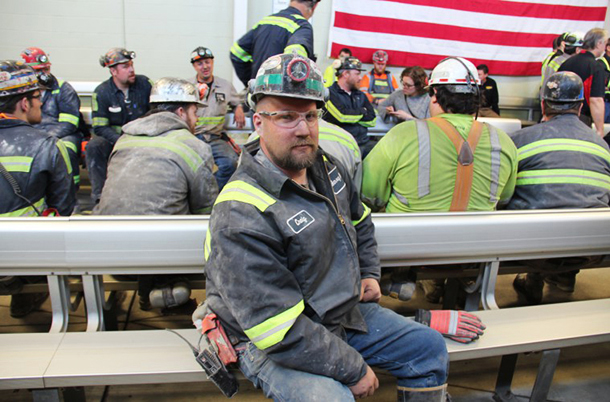
Craig Williams, a miner at Consol Energy’s Harvey Mine in Sycamore, PA. (Photo: Reid Frazier)
CURWOOD: While the numbers of US coal miners are declining, the ranks of renewable energy workers continue to swell. And there’s a case in point right in the heart of Pennsylvania’s coal country. The Allegheny Front’s Reid Frazier has this report.
FRAZIER: At Consol Energy’s Harvey mine--about an hour south of Pittsburgh--Craig Williams takes a mid-day break above ground, in a big room at the mine’s entrance. He’s in a hard hat, and he’s wearing a dusty, yellow-striped mining jacket. Though times have been tough in the coal industry, Williams and other miners here have managed to keep their jobs. He hopes to hang onto his job as a foreman.
WILLIAMS: Pittsburgh used to be big on steel. That’s mostly gone now. We’re one of the last, you know, industries around and hope to keep it that way.
FRAZIER: A father of two, he says, like generations before him, coal is the best way he’s able to support his family. Williams wouldn’t say how much he’s making, but nationwide coal miners make around $80 thousand a year.
WILLIAMS: If you had to take another job, in this area especially, you’re going to take anywhere from a 50 to a 70 percent pay cut to what the next best thing is that’s out there.
FRAZIER: But 40 percent of coal mining jobs have disappeared since 2011, and now only 50,000 of these jobs remain. Experts say automation, lower demand for electricity, and above all competition from cheaper fuels are what’s killing the industry. Those fuels include natural gas from fracking, and--increasingly--renewable energy.
Solar power now accounts for just under one and a half percent of electricity in the U.S. But according to the Department of Energy, Solar jobs now outnumber those in coal by more than 2 to 1. So, can laid off coal miners find jobs in solar?
GODBY: Well certainly it's a possibility, but there are a couple of major challenges.
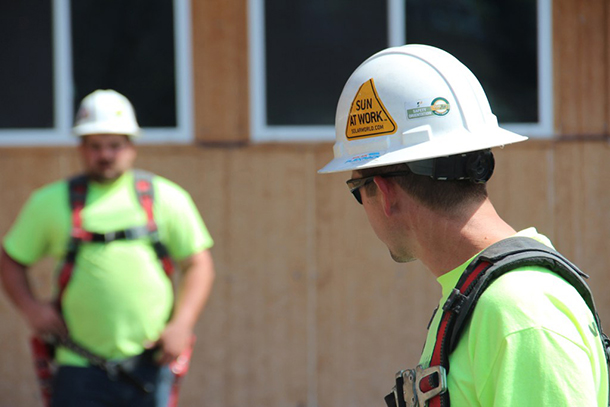
Solar jobs now outnumber coal jobs 2 to 1. But are laid off miners getting them? (Photo: Reid Frazier)
FRAZIER: Rob Godby is an energy economist at the University of Wyoming. He says one of those challenges is simple. Location.
GODBY: When you are thinking about coal mining in Appalachia, I mean, oftentimes there are generations of families in those regions, and it's just very difficult to pick up and move.
FRAZIER: And then, there’s pay. Coal miners make on average around $35 an hour, Godby says, in part because the job can be so dangerous. In renewables, the pay is more like $20 and $25 an hour.
GODBY: That doesn't mean you couldn't raise a family on that, but you're a lot closer to the average income in a lot of states in the solar industry than you are in mining industries.
[SOUND OF CONSTRUCTION]
FRAZIER: On a rooftop at a community center in Millvale, just outside of Pittsburgh, a gang of seven workers in neon green t-shirts bolt down solar panels. The crew includes 23-year-old Wylie Koontz, who worked at a coal mine, though as a lower paid contractor.
When he got laid off last year, he saw a job opening with Energy Independent Solutions, a local solar company.
KOONTZ: I didn’t like, just mentally be like, I’m going to completely switch. It just was a coincidence I just found this job it was about the same pay rate that I was making before, so I just went for it. Ended up really likin' it.
FRAZIER: One thing that did not weigh on his decision: Climate change.
KOONTZ: I don’t believe in the whole climate change thing or not. I mean, it good. It does takes the carbon for sure. It's a lot less, and it's a lot cleaner energy...
FRAZIER: But a steady paycheck, and not necessarily the environment, is what attracted him to the job. Koontz says he likes the problem-solving he gets to do in solar, and he could see himself staying in the industry.
Brian Krenzelak was a roofer before joining the company seven and a half years ago.

Workers for Energy Independent Solutions install solar panels at a Millvale, PA community center. (Photo: Reid Frazier)
[SOUND OF INSTALLING PANELS]
FRAZIER: Krenzelak installs solar and trains others, and he believes in the mission of green energy. His wife also works, and the couple have three kids, one in college, with another about to enter. They even have a second home in Florida.
KRENZELAK: You know, I do well with this company, very well. It covers what we need to cover. I mean, I'm not becoming a millionaire overnight but steadily have been building the nest egg for sure.
FRAZIER: Experts say solar’s boom is being helped by incentives that are schedule to run out in a few years. And they don’t know how long the surge in business will last. Some companies are reporting lower installations nationwide. But solar jobs in Pennsylvania grew last year by almost a quarter. And Krenzelak’s company, Energy Independent Solutions, is busy. Its looking to basically double its workforce of 22 over the next year and a half.
KRENZELAK: We had to slow the salesmen down at a certain point. We were selling so much solar. We had to actually slow them down a little bit until we caught up.
FRAZIER: Krenzelak likes the idea that his industry is up and coming. He says, when his crew went on a big installation recently, other contractors were curious about what they do.
KRENZELAK: So, there was iron workers there, carpenters, union laborers. Everyone’s coming up to us.
FRAZIER: He says it feels like solar is an industry of the future. And when he looks into the future, he likes what he sees. I’m Reid Frazier.
CURWOOD: Reid Frazier reports for the Pennsylvania public radio program, the Allegheny Front.
Related links:
- Listen to the story on the Allegheny Front website
- Annual coal mining wages stats from the National Mining Association
- “Can Coal Make a Comeback?” – Report from the Center on Global Energy Policy
- NYTimes: “Today’s Energy Jobs Are in Solar, Not Coal"
[MUSIC: Tommy Dorsey and His Orchestra, “Smoke Gets In Your Eyes” on The Best of Jerome Kern, Kern/Harburg, Chestnut Records]
India’s Renewable Energy Revolution

Gopal Singh and Kishen Lal install a solar panel in Mathura, a city in northern India, in 2014. The sprawling nature of the country makes massive centralized power projects costlier and less efficient than smaller, localized power sources. (Photo: Asian Development Bank, Flickr CC BY-NC-ND 2.0)
CURWOOD: For years India looked to advance development with coal. But growing concerns about air pollution and water crises linked to climate disruption have changed thinking among India’s leaders. And when India came to the 2015 climate talks in Paris, Prime Minister Narendra Modi led the launch of an international solar alliance to raise one trillion dollars to light up the developing world, and Living on Earth was there:
[INDIAN MUSIC]
MODI: Today, the world must turn to sun to power our future. As the developing world lifts billions of people into prosperity, our hope for a sustainable planet rests on a bold, global initiative. That is natural climate justice. The vast majority of humanity is blessed with generous sunlight round the year. Yet, many are also without any source of power. This is why this alliance is so important. We want to bring solar energy into our lives and homes by making it cheaper, more reliable, and easier to connect to grid.
CURWOOD: The alliance will develop best practices and common regulation, stimulate investment and solar product development, Modi said, and will become the foundation of the new economy.
MODI: This is an alliance that brings together developed and developing countries, governments and industries, laboratories and institutions, in a common enterprise. This day is the sunrise of new hope, not just for clean energy, but for villages and homes still in darkness, and for more mornings and evenings filled with the clear view of the glory of the sun. Thank you very much.
[APPLAUSE]
CURWOOD: And this promise has been turned into action with a revolution in green energy for the 1.3 billion people in India. Reporter Stephen Leahy wrote about this transformation in National Geographic, and came on the line with us. Welcome to Living on Earth.
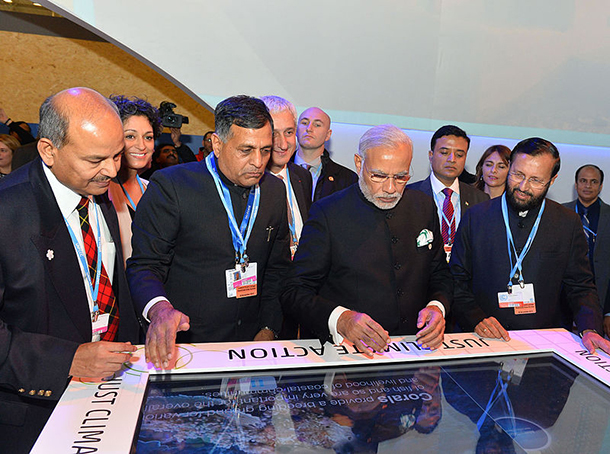
Prime Minister Modi (third from left in the front row) visits the Indian delegation at the 2015 UN Climate Change Conference in Paris. Modi used the talks as a platform to unveil India’s ambitious renewable energy goals. (Photo: Narendra Modi, Wikimedia Commons CC BY-SA 2.0)
LEAHY: Great to be here.
CURWOOD: So, Prime Minister Modi made a big promise at the Paris climate talks to bring solar energy to India and indeed the developing world. To what extent are we seeing that promise actually being carried out here?
LEAHY: Well, I think it's happening faster than anybody expected because it was a gigantic promise. Many people were skeptical that they could deliver, but in just these last two years, they have done remarkable things in terms of creating a new approach to bringing energy to an awful lot of people. A lot of people thought that even if they did try and do it, they couldn't do it this quickly. The perception about India may be that it's a bureaucratic government that takes a long time to make decisions, there's lots of red tape, but that seems not to be the case when it comes to this.
CURWOOD: You have been covering this for a long time, Stephen. How does this story feel? How exciting is this?
LEAHY: Yeah, I've probably been more excited about this that I have about anything in the last few years since Paris really. Paris was a big development, but that was talk. Now, India is delivering on the ground.
CURWOOD: For the record, how vulnerable is India to climate change?
LEAHY: Yeah, they're one of the most vulnerable countries. They've got water problems, water shortages. They've had huge heat waves that killed hundreds of people. They've got the sea level rise issue with most of the coastal areas. There's threats to their monsoon, which their agriculture is completely dependent upon. So, there's a whole range of real impacts already happening to India right now, and it's only going to get worse in the future.
CURWOOD: Now, as I understand it, there are more than a billion people in India and some 300 million who have no access to electric power. What are the biggest challenges to providing universal electricity access in India?
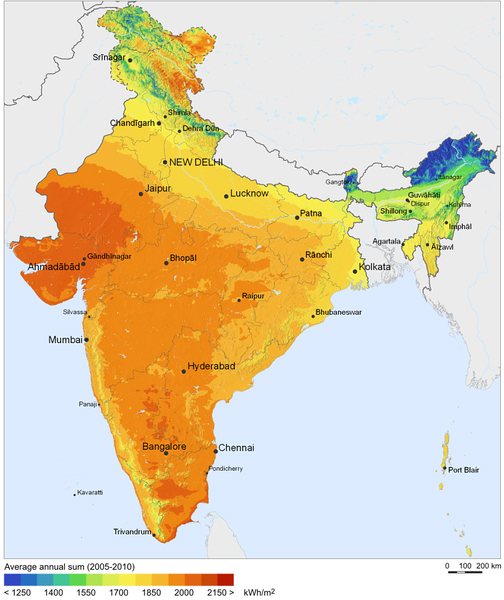
Most of India receives relatively high levels of sunlight, and has tremendous potential for solar power development. (Photo: SolarGIS GeoMode, Wikimedia Commons CC BY-SA 3.0)
LEAHY: One of the biggest problems is the cost. There’s lots of small villages spread out over a very large country, and these are poor people who can't afford to pay very much for electricity. So, the beauty of renewable energy is it's cheaper and it's decentralized, so it’s much easier to install a small solar panel set up or a couple of wind turbines to provide energy in really remote areas.
CURWOOD: So, what are the best benefits of adapting to renewable energy in India?
LEAHY: Well, I think it's the lower-cost. It's the lack of pollution. Right now India is mostly powered by coal, and they’ve had huge air pollution issues throughout the country. The other aspect that doesn't get as much recognition is the water usage. So all forms of electricity, with the exception of solar and wind, require a lot of good-quality water to generate electricity, and coal uses billions of gallons of water to heat and provide electricity, so we've got this country that has a lot of water shortages, not enough water to grow its crops. The farmers are forced to dig deeper and deeper into aquifers to pump water, to grow some food. Meanwhile, you have coal, of course, which requires lots of water.
CURWOOD: Now as you wrote, it's now cheaper to produce wind and solar energy in India than it is to produce coal energy. So, how has the country become so successful at lowering the cost of renewable energy?
LEAHY: Well, they have a massive market. That's one of the things that has really driven down the costs of renewable energy, I think not just in India but also round the world where the prices have been falling year on year. But what they're getting right now is a lot of financing from banks in financial institutions who see there's money to be made here. This isn't a charity project. This is a moneymaking venture for a lot of companies, so those folks who are installing the renewables and the wind, these are power companies who are borrowing money, millions of dollars from banks and they are planning on making some profits off of this.
CURWOOD: A number of years ago, folks in India were saying they would have to build a lot of coal-fired power plants to light all those homes that don't have electricity. Now they've switched over to renewable and link up to the fact that LEDs require a lot less electricity. How was India able to have that kind of integrated systems thinking, to move forward in this way?
LEAHY: Well, I think they've had strong leadership from their Prime Minister Modi that this is the future for India. They've also seen other benefits to renewable energy, for instance, right now India loses about 30 percent of all the energy it generates in transmission losses, but by having decentralized solar power and wind, they've really cut those transmission line losses, and that's a big savings in terms of energy. So, there’s multiple effects of savings of simply a lot of money that no longer needs to go into something as big and massive like a coal plant. Plus they could build renewal energy a lot faster than coal plants.

The Mundra Thermal Power Station in the Indian state of Gunjarat is the eleventh largest coal-based thermal power plant in the world. India’s climate goals include weaning itself off of fossil fuels, but as of now, the country is still primarily coal-powered. (Photo: Ariane Wilkinson, Flickr CC BY 2.0)
CURWOOD: Now, someone perhaps in the US or another advanced country will be saying, well, it's alright for India to have solar and wind, but their intermittent. The sun doesn't always shine, the wind doesn't always blow. Some electricity is better than none, but really it wouldn't work here because we need electricity 24/7. What's the response?
LEAHY: Well, I did ask that question to the Energy Minister Piyush Goyal, and his answer was, yes, we're going to have coal, we're going to coal to supplement when the wind doesn't blow and the sun isn't shining. We're going to need a combination of energy sources for India's future. But, at the moment, they've said that they're not going to build any new coal plants for probably the next decade. The few that are currently under construction they will complete. After that period of time they’re hopeful that they can slowly develop battery storage -- ways of storing renewable, intermittent energy -- that technology has been a bit expensive at this point but it's coming along very quickly as well, in terms of lower-cost. So, in the future they'll be able to store the renewable energy and that will mean they can wean themselves off coal.
CURWOOD: So, how many gigawatts of renewable is India planning to install in this program?
LEAHY: They plan to add 160 gigawatts over the next four years and they may be able to do that even sooner. For comparison, the US in 2015 had just over 100 gigawatts in solar and wind and of course that took several decades to build up to that 100 gigawatts.
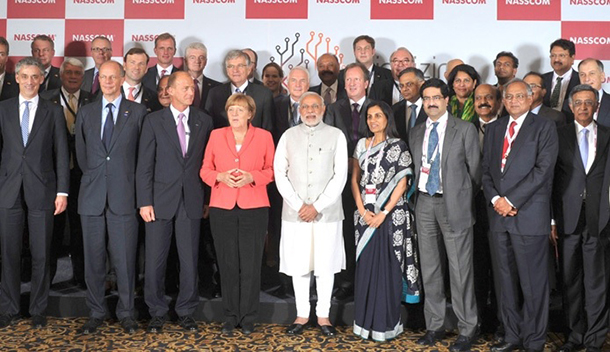
Prime Minister Modi attends a business forum in Bangalore with German Chancellor Angela Merkel in 2015. On Tuesday, Modi reiterated his commitment to partner with German leadership on global green energy policy. (Photo: Narendra Modi, Wikimedia Commons CC BY-SA 2.0)
CURWOOD: So, if the US doesn't get a move on, India is going to pass the United States, huh?
LEAHY: Yes, they will probably pass the US by the year 2022.
CURWOOD: Stephen, it seems to me that in a funny kind of way, India has an advantage with so many people without any electricity that they're leap frogging all that the costly infrastructure that we have -- your perception?
LEAHY: Well, they have a driving need to get electricity to people who don't have it and this is true in a lot of developing countries. They want change, they need change, they know they have to make change, so they're willing to put the resources and the urgency into having these things like renewable happen quickly, whereas, industrialized countries are already fairly comfortable, and we don't necessarily see a pressing urgency for change. So, I think that's part of the motivation. Secondarily, they don't need a lot of electricity. They just need a little bit of electricity for lighting to charge their phones. It's not necessary to provide the amount of electricity that the average American enjoys currently.
CURWOOD: What kind of transformation for a villager who had no electricity before does solar and/or wind bring to his village?
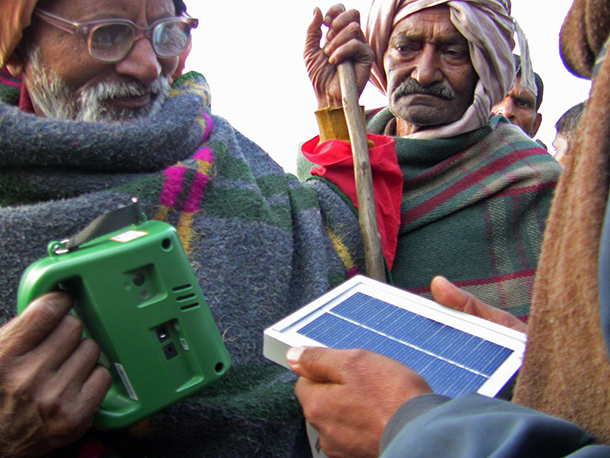
At a marketplace in Mankapur, India, locals inspect an LED lantern as a replacement for kerosene lights. The country has already successfully replaced 235 million household and street lights with LED technology. (Photo: Engineering for Change, Flickr CC BY-SA 2.0)
LEAHY: It could be huge because now at night instead of having a smokey lantern powered by using kerosene, which has its own hazards. It's a fire hazard. So, now with an LED light, a young student can do his homework in the evenings whereas it would have been too dark or the flickering light would've been also too expensive. LEDs are cheaper than kerosene. So, there's a number of things. They can also look at, well, there are now low-power LED kind of like, flash drive computers that used very little energy, so small little lap tops could be something that can be powered by -- easily powered by solar or by wind. So, these are all new things that will now be able to be part of the average village in India.
CURWOOD: I imagine with all this it'll be a huge leap the middle class for those people then, huh?
LEAHY: Yeah, and I think it will also be able to provide lots of services. So for instance, if you have access to the internet, and you're a farmer, well then you can get a better price for your crops because you'll know what the average selling price is for other regions. So, there's a whole pile of advantages that electricity will bring. I mean, let's face it. Who doesn't want to have electricity?
CURWOOD: So, the top emitters in the world, Stephen, as you know, China, the US and then India. Each country made pledges at Paris. India's plan ... how does this put it on the path to meet its promises at Paris, do you think?
LEAHY: Yeah, India going to meet its Paris commitments. It's going to, according to the latest analysis by scientists, if it is able to pull this off, which is what it's already in the middle of doing -- It will exceed those commitments and for comparison the US is not on track to make its Paris commitments, nor for that matter neither is Canada, unfortunately.
CURWOOD: We should note that you're Canadian.
LEAHY: Yes.
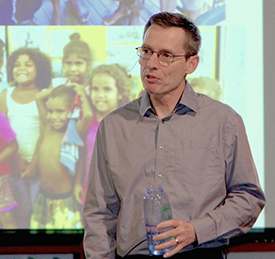
Stephen Leahy is an international environmental journalist. His recent coverage of India’s green energy transformation appeared in National Geographic. (Photo: Stephen Leahy)
CURWOOD: So Prime Minister Modi has a term that ends, I believe, in 2019. How critical is he in this green energy transformation and how lasting might these policies be if someone else were to take office there?
LEAHY: Well that's an important question. I think Prime Minister Modi has been essential to this transition, and I think by 2019 -- because so many things will have been delivered -- the LED lights, the access to energy for everyone in India, massive amounts of new, renewable energy -- I think it will be too far down the road for India to turn back completely. It's certainly possible that a new government might reemphasize coal, but I think the general public will have seen the benefits, they will have seen it's real, and they will, I think, understand that this is where India has to go for its future.
CURWOOD: What can other developing countries learn from India's energy transformation, do you think?
LEAHY: I think they've learned it can happen very quickly, that it's lower cost, and it can provide, like, you know, benefits to people who have not had access to electricity in a very short period of time, one or two years as opposed to a five or 10 year and hyper-expensive megaproject. And it brings real benefits to local people without having some of the downsides of massive infrastructure projects, which can be very disruptive. They won’t have the air pollution issues. They will also be protecting their water resources.
CURWOOD: And what about the United States? What can or should the US learn from India's progress on this energy transformation?
LEAHY: Well, I think they should understand that coal is not the answer, going back to coal and that fossil fuels … the day of fuel fuels is over. And that even a country that is a developing country with all sorts of social and other issues can make this rapid transition to renewable energy for the benefit of its citizens, but also for the benefits of this economy. They're building what we might call a 21st century economy around renewable energy.
CURWOOD: Stephen Leahy is an independent journalist covering international environmental issues. His most recent reporting on India's renewable energy transformation appeared in National Geographic. Stephen, thanks so much for taking the time with us today.
LEAHY: You're very welcome.
Related links:
- National Geographic: “India Launches Massive Push for Clean Power, Lighting, and Cars”
- Washington Post: “As Merkel seeks allies elsewhere, Modi visits Berlin bursting with friendliness”
- From the LOE archives: "India's Solar Initiative and the Challenge of Climate-Safe Development"
- Stephen Leahy’s website
[MUSIC: Cyrus Chestnut, “Peace” on Spirit, composed by Horace Silver, Jazz Legacy Productions]
CURWOOD: Coming up, why people hurt by pollution sometimes oppose environmental protections. That’s just ahead here on Living on Earth, stay tuned.
ANNOUNCER: Funding for Living on Earth comes from you our listeners and United Technologies, combining passion for science with engineering to create solutions designed for sustainability in aerospace, building industries, and food refrigeration. UTC companies such as Otis, Carrier, Pratt and Whitney, and UTC Aerospace systems are helping to move the world forward. You can learn more about United Technologies by tuning into the Race to Nine Billion podcast; listen at race to nine billion dot com. That’s race to nine billion dot com. This is PRI, Public Radio International.
[CUTAWAY MUSIC: Jake Shimabukuro “Every Breath You Take”, https://www.veojam.com/watch/1426402059]
Strangers in Their Own Land: Anger and Mourning on the American Right
.jpg)
An aerial view of the sinkhole at Bayou Corne (National Nuclear Security Administration, Flickr CC BY-ND 2.0)
CURWOOD: It’s Living on Earth, I’m Steve Curwood. Voters in Republican-leaning states sometimes vote against candidates and measures that would protect their health when it comes to regulating air quality and stream pollution. At the same time, Democratic-leaning states are more likely to adopt such measures and candidates who promote them. To try to understand and bridge the partisan divide over the environment, sociologist and liberal Arlie Hochschild conducted what she calls “an empathic study” of her political opposites in Louisiana for her book, “Strangers In Their Own Land.” Arlie is a professor at the University of California, Berkeley and she joins us. Welcome to Living on Earth!
HOCHSCHILD: Well, thank you. I'm delighted to be here.
CURWOOD: So, briefly describe for me the project that this book is the result of.
HOCHSCHILD: Already five years ago I was concerned about a growing split between left and right across the country, and I realized that I lived in an enclave, a geographic enclave, a media enclave, an electronic enclave, and that we all do. So, I decided to get out of my enclave in Berkeley, California, and go as far right as Berkeley, California, is left. Take my moral and political alarm system off and try to really cross over an empathy wall.
CURWOOD: And you chose Louisiana for this project. What makes Louisiana such an ideal choice for the kinds of perspectives you were hoping to document?
HOCHSCHILD: I wanted to go where the right was the strongest and had grown the fastest and that was the south. Actually, when you look at the proportion of whites who voted for Barack Obama in 2012, in California it was half. In the south as a whole region, it was a third. But in Louisiana it was 14 percent, so I thought, “It's the Super South, that's perfect, that's just where I want to go”.
CURWOOD: It would seem, these people who lost their neighborhood, much of a way of life should be interested in the federal government trying to clean things up, but it's exactly the opposite. Why?
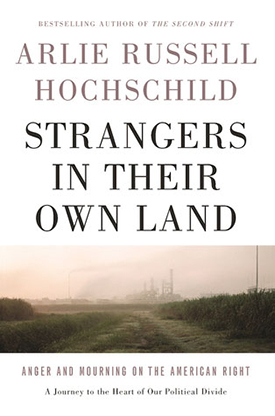
Arlie Hochschild’s newest book is a sociological investigation of the American right. (Photo: The New Press)
HOCHSCHILD: Well, let me just say to begin with that the people I came to meet love the birds, and they love the water and they love the grand Cypress trees, these queens of the wetlands. They love nature, and it wasn't that they didn't know about the pollution. Yes, of course, they did. Louisiana has the second highest death rate from cancer for men.
So, I think there were three things. They felt that the federal government, that was the north, and it was always wagging its moral finger at the south, and they felt that environmentalists were, you know, the last in a series of northerners coming down to tell them the right thing to do.
I think the next most important reason they distrusted the federal government is their experience with protective agencies in the state of Louisiana, and they thought, “Gosh, these are a lot of people we pay taxes to but they don't really protect us.” And they’re right, because Louisiana is an oil state - that was a big discovery for me - and it outsources, in a way, the moral dirty work to the state. So, the state actually pretends to protect the citizenry from hazardous waste and pollution of air and water and ground, but it doesn't actually protect it very much. It gives out permits, as one Tea Party person said "like candy." And so, they felt the federal government is just a bigger, badder version of a state government which isn't protecting us. So, they'd had bad experience. They’d been burned, and I think that's the second kind of source of resistance to the government. But the third is that they saw the government as an instrument of what I'll call “the line cutters.”
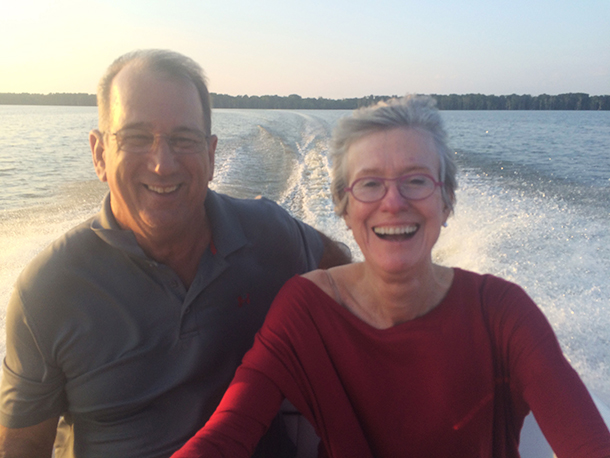
Arlie Hochschild and Bayou Corne resident Mike Schaff. (Photo: Arlie Hochschild)
CURWOOD: This “line cutters” concept is really a fascinating one in your book. Stop for a moment and tell me exactly what do you mean by “line cutters,” and why people in the south...although I imagine anybody listening to us probably doesn't really like the notion of somebody coming in front of them if they're waiting for something.
HOCHSCHILD: The right deep story is this. You're waiting in line for the American dream. It’s as in a pilgrimage, looking at the top of the hill at which stands this much desired American dream, and you're not in the back of the line, but it hasn't moved for many, many years. Some people I interviewed hadn't gotten a raise in two decades. So, your feet are getting tired. You feel like you don't bear grudges to any particular group. You're a good person. You've worked hard. You've played by the rules, and you deserve the prize at the top of the hill.
Then, you see some people that seem to you to be cutting in line. Well, who are they? They are blacks, who now through federally mandated, affirmative action program, have access to jobs that used to be reserved for whites. Even worse, women who through federally mandated affirmative action now have access to jobs that used to be available only to men. And then you have immigrants, and then you have refugees. So, all these intruders.
And then, another moment of the right's deep story. Barack Obama, supervisor of this line, seems to be waving to the line cutters. In fact, you know, isn't he sponsoring these line cutters, and isn't he a line cutter? Many people said to me, “How did a single mother, his mother, pay for a very expensive education at Harvard and Columbia. Something fishy.” So, they felt that he too wasn't obeying by the rules.
CURWOOD: Arlie, you don't talk much about race in your book. In the south, no matter how bad things were, you could look back and say well the blacks have it worse, the Negroes have it worse. So, it seems that part of this distrust of government may come from this change, this loss of comfort that, well, no matter how tough it is for poor white folks, that there are poor black folks behind them, and that comfort goes away or is going away.
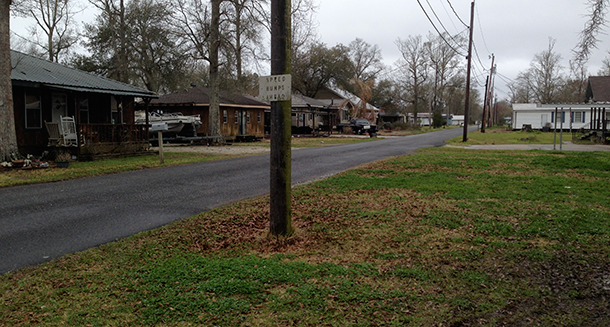
In 2014, Bayou Corne was -- for the most part – devoid of its residents. (Photo: Emmett FitzGerald)
HOCHSCHILD: Right. They don't think of themselves as racist, are insulted to turn on the television and see that they are seen this way. One man told me, “Oh, it's only the liberals that think we’re more racist than they are.” And many people said, “Look, racism isn't gone by a long shot in this country, but we're not the only ones.” And race was, of course, an enormous part of the story and I do talk about it in the book, but it was woven together with the sense of decline and fear and sense of being invisible to the authorities.
CURWOOD: Now, among other instances of industrial pollution that your book discusses, Arlie, you deal with the sinkhole that appeared in Louisiana in 2012. It formed in a Cypress grove just outside of a town called Bayou Corne. The cavern was created by a collapsed underground salt dome cavern operated by Texas Brine, a company that was there extracting sodium chloride, salt, for plastic production. Hundreds had to be evacuated from their homes, and it was only in 2016 that the mandatory evacuation order was lifted. Now, Emmett FitzGerald reported for Living on Earth from Bayou Corne in 2013. Let's listen to an excerpt from one of his pieces where he met with residents who were worried about the danger of explosive gas collection in the cavern.
FITZGERALD: Jennifer Gregoire, living on Sauce Picante has decided to live with that risk. She says she doesn't have much of a choice.
GREGOIRE: I understand the dangers and the risk I'm putting my family in, but it's cheaper and it's easier. I can't afford to buy nothing else.
FITZGERALD: The Gregoires are one of only about 20 families left in Bayou Corne. If a car drives down Sauce Picante today, it's likely either disaster tourists or looters. Jennifer says it's no longer a good place to raise a family.
GREGOIRE: My son just had a birthday. We can’t [SOUND OF GREGOIRE CRYING], we couldn't throw a party for him this year at the house. That was bad. Nobody wants to come here.
CURWOOD: That's Bayou Corne mother Jennifer Gregoire in Emmett Fitzgerald's story. Now, in your research into Bayou Corne, the Bayou Corne sinkhole, you spoke with Bayou Corne resident Mike Schaff. Now, Schaff loses a lot, but why does he continue to oppose federal environmental regulations and in spite of his own self-professed desire to protect the environment?
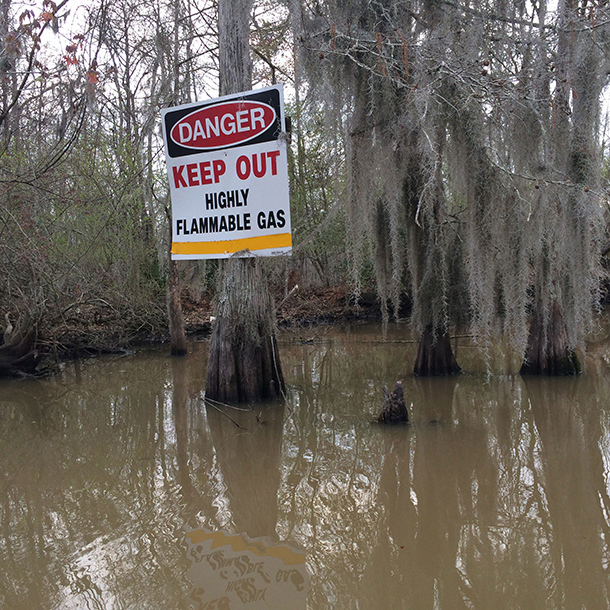
High levels of hydrogen sulfide were detected at a Texas Brine Company well near the sinkhole back in 2012. (Photo: Arlie Hochschild)
HOCHSCHILD: Yes. You know, it's poignant because the first thing Mike told me is, "You know the problem with federal government is, it takes community away. It supplants community. We ought to do for each other the things that government does for us. We're better off if we have local type community."
But it wasn't the presence of government that took a community away from Mike Schaff. It was the absence of government regulation that took community away from Mike Schaff, and when we talked about that later on a fishing trip and, more recently, I brought my son who is a California environmentalist, a member of the Energy Commission in charge of renewables – so, a progressive Democrat just the opposite of Mike - and we went out fishing, the three of us. And I said, "Look I'm going to hold the tape recorder, but I'd like us to get together and tell me, is there common ground on how to prevent another Bayou Corne sinkhole from ever happening in America"?
And they went to it, and they did come up with some common ground. And Mike, very hesitant to call for regulation, he had been so exposed to a bad model of government, and he'd spoken out at one after another after another meeting to deaf ears, and he feared that the federal EPA was as bad as the Louisiana one. And yet when David said, "Yeah, but what else are we going to do here? And there is a possibility of good government. Look, over in California we have a much more tight regulation and less pollution, and you could have it too." And when he put it that way, Mike said, "Well, it's not fair that some states are the polluted states and have the worst health. We should live in the United States where every state has the same degree of health and cleanness of the environment."
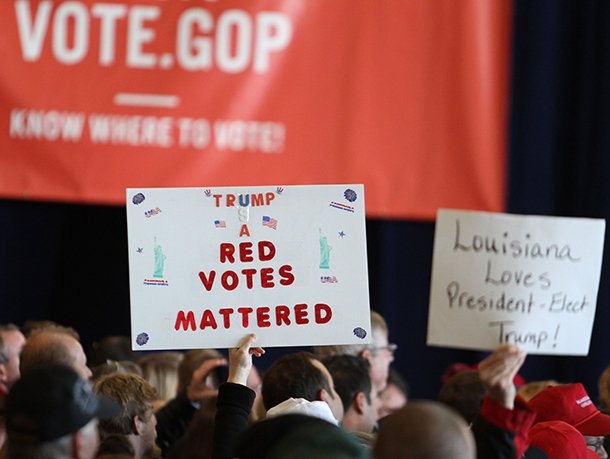
Strong support in Southern conservative strongholds was key for Trump’s presidential victory. (Photo: Tammy Anthony Baker, Flickr CC BY 2.0)
CURWOOD: So, the common theme of your book is, these folks who really have been given the short end of the environmental stick, and you kind of divide them – You’re a sociologist - so you have sort of three categories of folks that you talk to. I think the one category you call “the team players.” Another you call “the believers” or “the worshipers,” and then you have a category that you call “the cowboys.” Who are these people and what influences their Tea Party politics in the face of environmental, well, really, environmental dysfunction and environmental degradation?
HOCHSCHILD: The team player is a person who says, “I am fundamentally conservative Republican, and whatever conservative Republican leadership is telling us is the right thing to do. I'm on board for that, and I'm going to be loyal to this team, my team”.
The second would be the worshiper, and here were people who say, “You know, you can't always get what you want.” And I met people who loved the environment, who knew about it in great detail. It hurt them to see a child go swimming in a lake that they knew was polluted, so it's not that they had inured themselves to a love of nature. No, but they felt like they had to renounce that love and in a way say, “Look, pollution is the sacrifice we make for capitalism.”
And the third would be the cowboy. The cowboy very differently from that says, “You can't afford to love nature.” What he does is say, “Look, I'm tough. You're tough. Mother Nature's tough. We're all tough, and she can take it. You know, Mother Nature will recover. I won't be hurt. You won't be hurt”. Each of them takes pride at a different moment, takes honor from a different emotional moment in their heart.
CURWOOD: Arlie, drill down a bit for me on one of these. Tell me, particularly, what role does Christianity play in how the far right thinks about environmental regulation? Those people who look to fundamental Christianity.
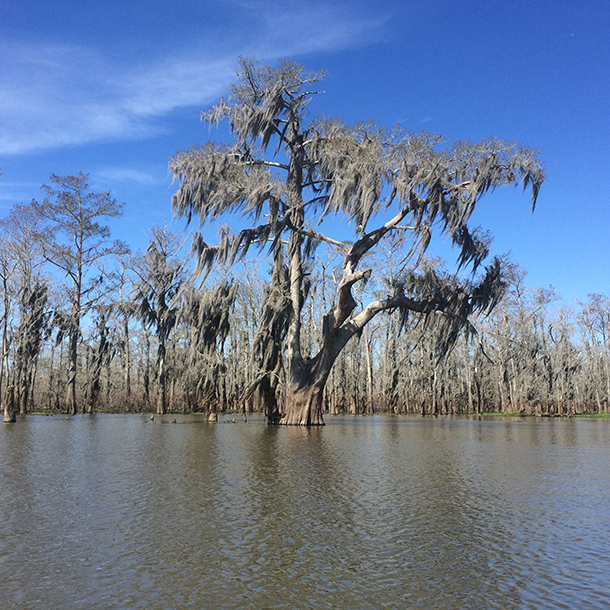
The Cypress tree is the iconic state tree of Louisiana. (Photo: Arlie Hochschild)
HOCHSCHILD: Yes, many of the traditional leaders of the Evangelical church have put a great distance between their faith and protection of the environment so that environmentalists are seen as almost animists, you know, that worship the Earth instead of God, but there's a growing group of Evangelicals who have embraced the idea of creature care and that this is God's creation, and we must protect it for posterity. And… but they do it with, again, a different set of meanings. There are people, a group of Christians for saving mountain tops, but it's for the sake of the unborn child, so it's got a different take.
CURWOOD: You know, recent statistics show that the life expectancy of white working-class people is declining in this country. How might this be tied to the appeal of the Tea Party to folks who are nonetheless suffering some substantial environmental outrages?
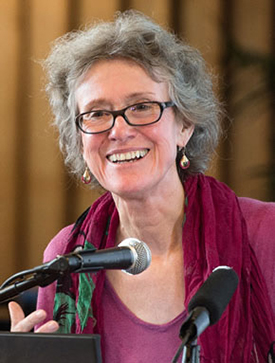
Arlie Russell Hochschild is a Professor of Sociology at the University of California, Berkeley. (Photo: University of California Berkeley)
HOCHSCHILD: Yes, you're right, declining, and there's a higher rate of suicide and drug abuse and alcohol abuse. It's a despair. It's a sign of despair, actually. It's almost like what happened to black men, what hit black men earlier. It's hitting blue-collar, white men now, or the fear of it, that the decline of jobs - automation being a major cause of that - is terrifying.
CURWOOD: You spent many hours in conversation with Donald Trump supporters. You did the end of your research just as the election was approaching. How does Donald Trump's rhetoric on environmental issues appeal to these folks on the Tea Party right? Or is there something else about what he says that appeals over the environment and other matters?
HOCHSCHILD: You have it right the second way. They don't love him for selecting Pruitt who's now going to cut the EPA by a quarter of its staff and undermine the Clean Air and Clean Water Act. No, but they do like the whole idea of a candidate who seems to recognize them. They almost felt like a minority group. Even though they're a majority, they felt that way. I think of Donald Trump as an antidepressant. You know, you see anger, but in the title of my book there's also mourning. You know, anger and mourning on the American right.
CURWOOD: Arlie Russell Hochschild is a sociology professor at the University of California, Berkeley. Her book is called "Strangers in Their Own Land: Anger and Mourning on the American Right." Thanks for taking the time with me today.
HOCHSCHILD: It's been a great pleasure.
Related links:
- Strangers in Their Own Land
- Emmett Fitzgerald’s entire Bayou Corne segment
- Arlie Hochschild’s UC Berkeley Faculty Page
[MUSIC: Kohala “Deeper Blue” from Deeper Blue Charles Michael Brotman/Charlie Recaido Palm Records]
EARTH EAR – LANG ELLIOTT – LACASSINE POND, LOUISIANA
[SOUNDS OF DAWN CHORUS]
CURWOOD: We leave you this week deep in a Louisiana bayou.
[SOUNDS OF DAWN CHORUS]
It’s dawn in early spring, at Lacassine Pool, a National Wildlife Refuge.
[CHATTERING BIRDS, CHUCKLING LEAST BITTERNS]
Red-winged blackbirds are calling from the thickets around the pool, along with melodious Northern Cardinals and gravel-voiced Boat-Tailed Grackles….
[SOUNDS OF DAWN CHORUS, INCLUDING FROGS]
Along the water’s edge, a Common Moorhen darts in and out of the rushes, and a Least Bittern calls, above a chorus of Northern Cricket Frogs.
[SOUNDS OF DAWN CHORUS]
Lang Elliott recorded this dawn chorus in February, for his sound project, The Music of Nature.
[MUSIC: Dr. John, “I’m an Old Cow Hand” on Mercernary, Johnny Mercer, Parlophone Records]
CURWOOD: Living on Earth is produced by the World Media Foundation. Our crew includes Naomi Arenberg, Bobby Bascomb, Thurston Briscoe, Savannah Christiansen, Jenni Doering, Anna Gibbs, Don Lyman, Maggie O’Brien, Aynsley O’Neill, Sarah Rappaport, Jake Rego, Adelaide Chen, and Jolanda Omari. Tom Tiger engineered our show. Alison Lirish Dean composed our themes. You can hear us anytime at L-O-E dot org, on iTunes or Google Play music - and like us, please, on our Facebook page - PRI’s Living on Earth. And we tweet from @livingonearth. I’m Steve Curwood, thanks for listening!
ANNOUNCER: Funding for Living on Earth comes from you our listeners and from the University of Massachusetts, Boston in association with its School for the Environment, developing the next generation of environmental leaders. And from the Grantham Foundation for the Protection of the Environment, supporting strategic communications and collaboration in solving the world’s most pressing environmental problems. Support also comes from the Energy Foundation, serving the public interest by helping to build a strong clean energy economy.
ANNOUNCER 2: PRI, Public Radio International.
Living on Earth wants to hear from you!
Living on Earth
62 Calef Highway, Suite 212
Lee, NH 03861
Telephone: 617-287-4121
E-mail: comments@loe.org
Newsletter [Click here]
Donate to Living on Earth!
Living on Earth is an independent media program and relies entirely on contributions from listeners and institutions supporting public service. Please donate now to preserve an independent environmental voice.
NewsletterLiving on Earth offers a weekly delivery of the show's rundown to your mailbox. Sign up for our newsletter today!
 Sailors For The Sea: Be the change you want to sea.
Sailors For The Sea: Be the change you want to sea.
 The Grantham Foundation for the Protection of the Environment: Committed to protecting and improving the health of the global environment.
The Grantham Foundation for the Protection of the Environment: Committed to protecting and improving the health of the global environment.
 Contribute to Living on Earth and receive, as our gift to you, an archival print of one of Mark Seth Lender's extraordinary wildlife photographs. Follow the link to see Mark's current collection of photographs.
Contribute to Living on Earth and receive, as our gift to you, an archival print of one of Mark Seth Lender's extraordinary wildlife photographs. Follow the link to see Mark's current collection of photographs.
 Buy a signed copy of Mark Seth Lender's book Smeagull the Seagull & support Living on Earth
Buy a signed copy of Mark Seth Lender's book Smeagull the Seagull & support Living on Earth

